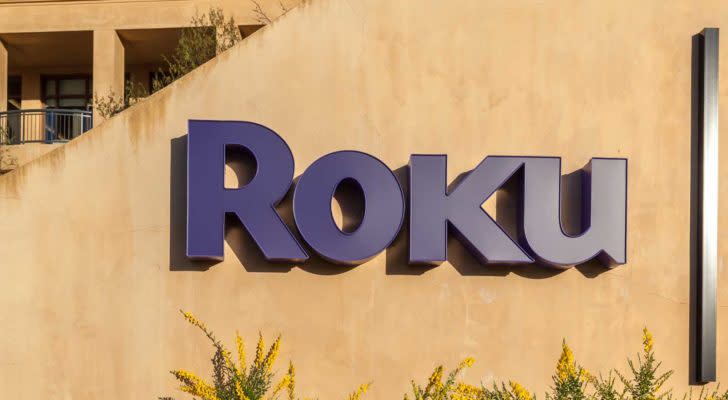Roku Stock Seems Overpriced Despite Acceleration in Cord Cutting
Roku (NASDAQ:ROKU) continues to benefit from a massive cord-cutting movement away from traditional cable TV. However, Roku stock is likely overpriced since it is still making losses. Nevertheless, Roku expects to pick up many more subscribers and streamers moving away from “linear” TV viewing.

Source: JHVEPhoto / Shutterstock.com
Last year, the company’s revenues grew by 52%. This upward trend should continue this year as a result of the Covid-19 pandemic, as I pointed out in my last article. Since that article in mid-March, Roku has skyrocketed over 70%. The reason is this year analysts expect revenue to climb at least one-third to $1.5 billion.
In addition, by 2021, revenue should hit $2 billion, according to analysts polled by Seeking Alpha. Therefore, in the space of two years by the end of 2o21, revenue will be up by almost double.
InvestorPlace - Stock Market News, Stock Advice & Trading Tips
So the market and analysts expect profits to rise dramatically as a result. Most of this is from what Roku calls an acceleration of the “re-platforming” of TV from cable to streaming.
The Cord Cut and Shave Movement
On July 21, Roku released interesting results from its annual cord-cutting survey. Nearly half of U.S. TV households say they watch more free, ad-supported TV. In fact, as it stands now, one in three U.S. households are now cordless.
Moreover, the survey found that 25% of households have cut back their cable TV, becoming cord “shavers.” The study found that 45% of these people claim they will likely fully cut their cord completely.
Two reasons were cited for these huge driving forces away from cable TV. First, the Covid-19 pandemic forced many indoors for long periods.
Second, that lack of live sports forced many to decide to cut the cord. Both forces have as a base a desire to lower expenses while streaming more free TV. This includes free preview periods with various online channels.
As a result, these forces should continue to provide a good boost to Roku’s revenues and earnings.
Q2 Revenues and Earnings Reinforce These Trends
On Aug. 5, Roku disclosed its Q2 revenue and earnings, which were very impressive. For example, sales grew 42% year-over-year. It generated the largest net gain in accounts in its history outside of a Q4 holiday.
Moreover, adjusted earnings before interest, taxes, depreciation, and amortization (EBITDA) turned positive for the first time. Roku generated $11.1 million in quarterly adjusted EBITDA. This represents a 4.4% margin on sales. Last year, and in prior quarters over the last 12 months, Roku produced negative adjusted EBITDA results. This increase in profitability is very significant.
Nevertheless, analysts still expect Roku to make net income losses this year. Roku’s prior guidance was for 2020 shows between negative $10 million and positive $10 million in adjusted EBITDA. With this latest quarterly release, the company said it is likely to post an adjusted EBITDA loss. But it did not give a precise number forecast.
Expectations and Valuation
To see if Roku stock is a bargain today, let’s assume that it makes an adjusted EBITDA of $10 million in 2020. We can compare this to its Enterprise Value (EV).
EV is equal to its market capitalization less cash plus its net debt. Roku’s market cap is $18.8 billion. Since it had $483.4 million in net cash at the end of June, after deducting total debt and operating leases, its EV is $18.31 billion.
Therefore, Roku’s EV-to-Adjusted EBITDA this year will be 1,831 times. But if revenue rises next year to $2 billion from $1.5 billion, we can optimistically assume adjusted EBITDA will rise as well.
Let’s assume that at least one-third of that increase will go to adjusted EBITDA. So next year Roku’s adjusted EBITDA could climb to $166.65 million, i.e. one-third of $500 million. As a result, the 2021 EV-to-Adjusted EBITDA ratio will be about 110 times. That is still a very high ratio, even if the optimistic assumption of a 33% adjusted EBITDA margin.
That ratio could get lower if Roku’s adjusted EBITDA numbers increase. Presumably, this will happen in the years following 2021. But we are already making assumptions upon assumptions.
What to Do With Roku Stock
Roku is already up about 15% so far this year. This is after having fallen 45% by mid-March. In effect, it is now up over 118% from its mid-March lows. This is a clear sign that investors expect Roku to be a winner despite the economic dampening effects of the Covid-19 pandemic.
I suspect that the company will start producing both EBITDA and net income profits sooner than expected. This is because Roku is now seeing an acceleration in cord-cutting trends.
Therefore, I believe the EV-to-EBITDA ratio could drop to below 20 times by 2022 or 2023. That is what the market is counting on now. But that is very risky. So far, Roku has produced only one quarter of adjusted EBITDA profits.
One risk is that after a vaccine is widely available and live sports on cable start, the current cord-cutting trends could slow down. That risk may not be adequately priced into the stock price.
Therefore, I think there is not as much upside as before. The market is already discounting a lot of positive trends in Roku stock. The best course would be to wait for another dip in the stock when you can pick it up at a lower price.
As of this writing, Mark Hake, CFA does not hold a position in any of the aforementioned securities. He runs the Total Yield Value Guide which you can review here.
More From InvestorPlace
The post Roku Stock Seems Overpriced Despite Acceleration in Cord Cutting appeared first on InvestorPlace.
